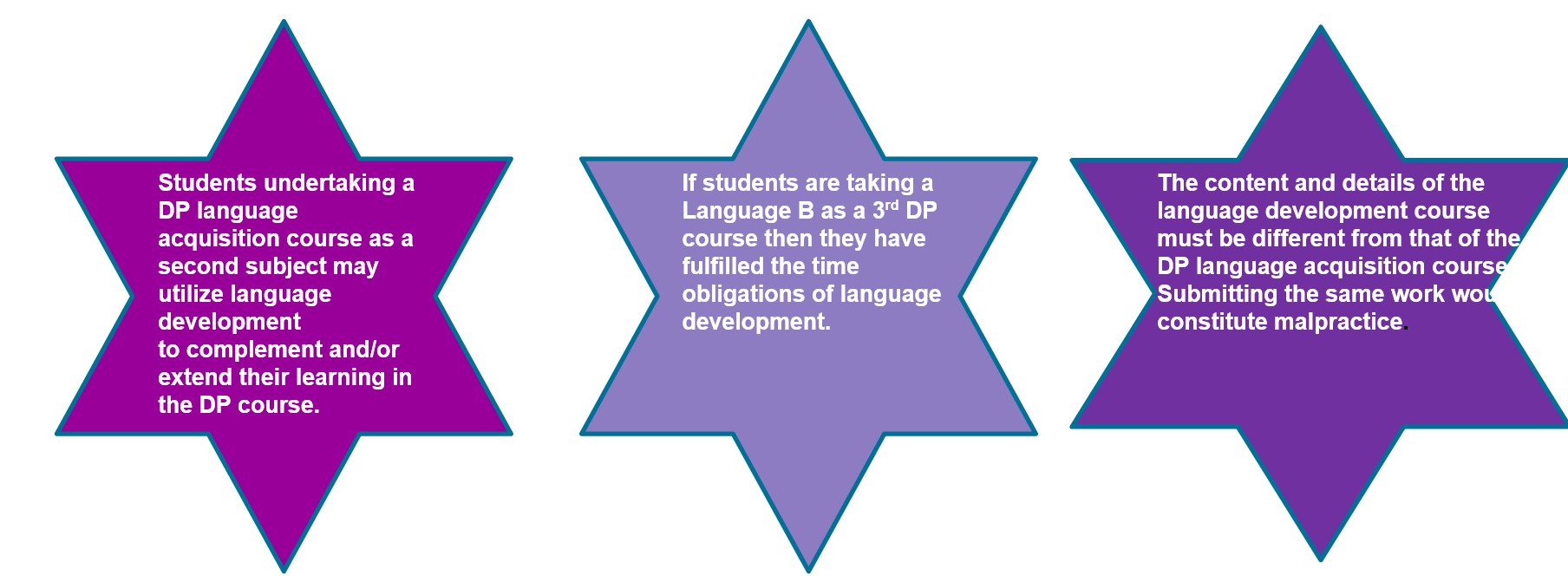Language Development

Language Development
Making up on of the four key core elements, Language Development celebrates the individual's unique lifelong relationship with language learning and intercultural understanding. The role that culture and traditions might play in the student's 50 hours of language development can be overlooked in favour of a more traditional language acquisition course. Is this missing an opportunity? Irrespective of how you approach this, how can the students get the most out of the experience?
The Language development guide 2016
'Language development aims to provide students with the necessary skills and intercultural understanding to enable them to communicate in an environment where the language studied is spoken. This process encourages students to go beyond the confines of the classroom, expanding their awareness of the world and fostering respect for cultural diversity'

Designing Language Development
Reflect your unique context
The CP has established itself on its fixed and flexible approach to its course design which allows schools to make it truly unique to their context. Arguably this is seen no better than in the language development requirement of the programme's core. When choosing the direction that you would like your students, staff and school to go in terms of language development, there is a need to synchronise the context of the CP with your own school's context.
 Start discussing the fixed and flexible nature of the course
Start discussing the fixed and flexible nature of the course
| Fixed | Flexible | What does this mean for students? |
|
| Students study the language that:
Students may choose to study:
|
 Then, remember the context within which is sits and the following characteristics of the whole core
Then, remember the context within which is sits and the following characteristics of the whole core
- The core is a mandatory two-year course of study where all components are studied concurrently
- The course design should draw out students' personal qualities and professional development
- The core contextualises the rest of the CP course and draws together all aspects of the DP courses and the career-relates study that the students are taking
- The core is a forum to develop the IB Learner Profile
 Finally, reflect on a key question:
Finally, reflect on a key question:
What are the personal and professional language needs of each individual student?'
- What role does the Language development requirement play in the CP?
- What are your language development needs for students and staff?
- How would you like to see the Language development requirement integrated into your whole core programme?
- Looking back over your language development success stories: what strategies have proved to work in supporting planning and development courses?
Recognising the difference between LA and LD
Schools can make the mistake of not fully understanding or realising practically the difference between language acquisition and language development.
How can you use Language Acquisition courses as part of the Language development requirement?

Starting the Language development journey
 PPS theme: Intercultural Understanding
PPS theme: Intercultural Understanding
At the beginning of this course, it is essential that students create a 360 degree language and portrait, personal to them through a questionnaire. This questionnaire should provide students with a place to identify their language(s), draw conclusions about their language(s) and culture(s), and set some initial goals for their own language development.
This exercise works well within the PPS framework and their initial exploration of Intercultural Understanding. These questions are designed to spend time on and for the student to develop ideas over a period of time rather than being a 'gut reaction'. First of all, ask students what questions should be asked when starting out on a language development course.
1. What language/s do you use and for what purpose?
2. What can you do with language? What can you not do with language?
3. What are your cultural influences that have impacted your life?
4. Would you say you belong to more than one culture? Do you have friends from different cultural background that you are particularly interested in?
5. Is their a relationship between language and culture?
6. Why could learning a language be important to you?
7. What language do you think you will study in your language development? Do you have a shortlist?
8. Why have you chosen that specific language for language development?
9. How do you think you could use your target language in the future?
10. What links and connections are there between the language and your CRS and other core components?
Why not look at how PPS can be used to create links to a student's individual language development course
Language development and PPS
This page takes a step back for students to consider language development, language acquisition and linguistic skills in a broader more conceptual way that links directly to their personal development,...
In these short activities, students are asked to take a step out of their context and consider themselves as users of language. This is very much intended as embracing all PPS themes in some way but you may want to zoom in on one in particular. It certainly makes for a good introduction to Personal Development which can be revisited throughout their CP journey.
This activity is not focused on language proficiency but about the way we use and change the we speak for particular people and environments. Taking inspiration from a fascinating BBC podcast called Deeply Human, students can consider the broad question of why people speak the way they do, and how this develops and changes over time. Thrown in as well are some opportunities for active listening and communication skills development. Also provided is a transcript of the podcast with soundbytes from experts which can be activators for whole class discussion.

